Leading and Managing Organisational Resources Report (BSS064-6)
VerifiedAdded on 2023/01/05
|9
|1947
|40
Report
AI Summary
This business report examines the impact of the COVID-19 pandemic on workforce planning and the crucial role of leadership in navigating these challenges. It highlights the shift to remote work, the importance of employee well-being, and the need for leaders to adapt their strategies. The report emphasizes the necessity of addressing employees' needs for stability, safety, and security while also fostering social cohesion and trust. It explores various strategies, including building trust through communication, focusing on workforce effectiveness, tailoring approaches to individual needs, and adapting to changing circumstances. The report stresses the significance of leaders providing constant support, implementing technological advancements, and creating a culture that values employee input and well-being to ensure organizational success in the face of ongoing challenges. The report concludes by providing strategies for leaders after the pandemic becomes normal, including building trust, focusing on workforce effectiveness, and tailoring approaches to meet individual needs.
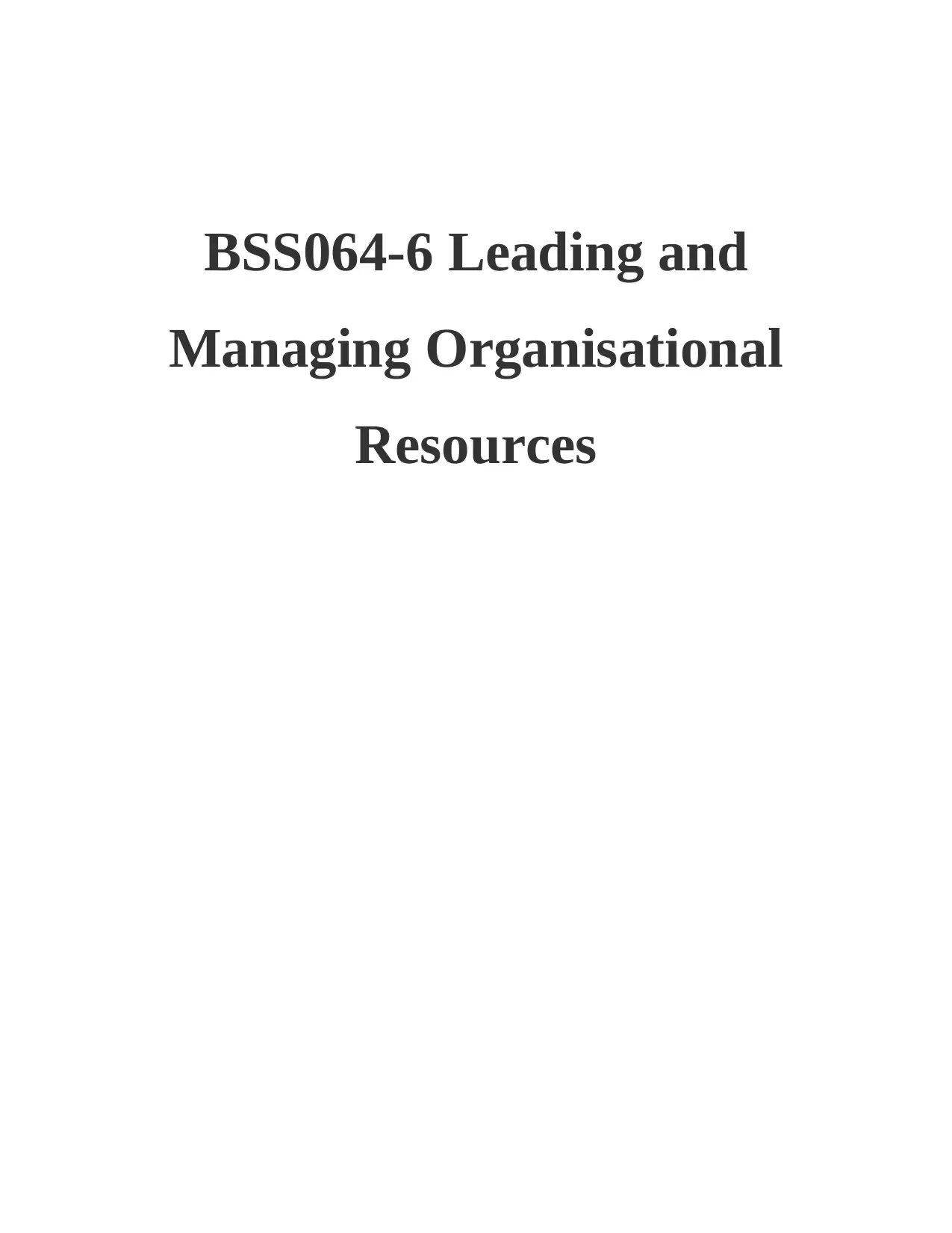
BSS064-6 Leading and
Managing Organisational
Resources
Managing Organisational
Resources
Paraphrase This Document
Need a fresh take? Get an instant paraphrase of this document with our AI Paraphraser
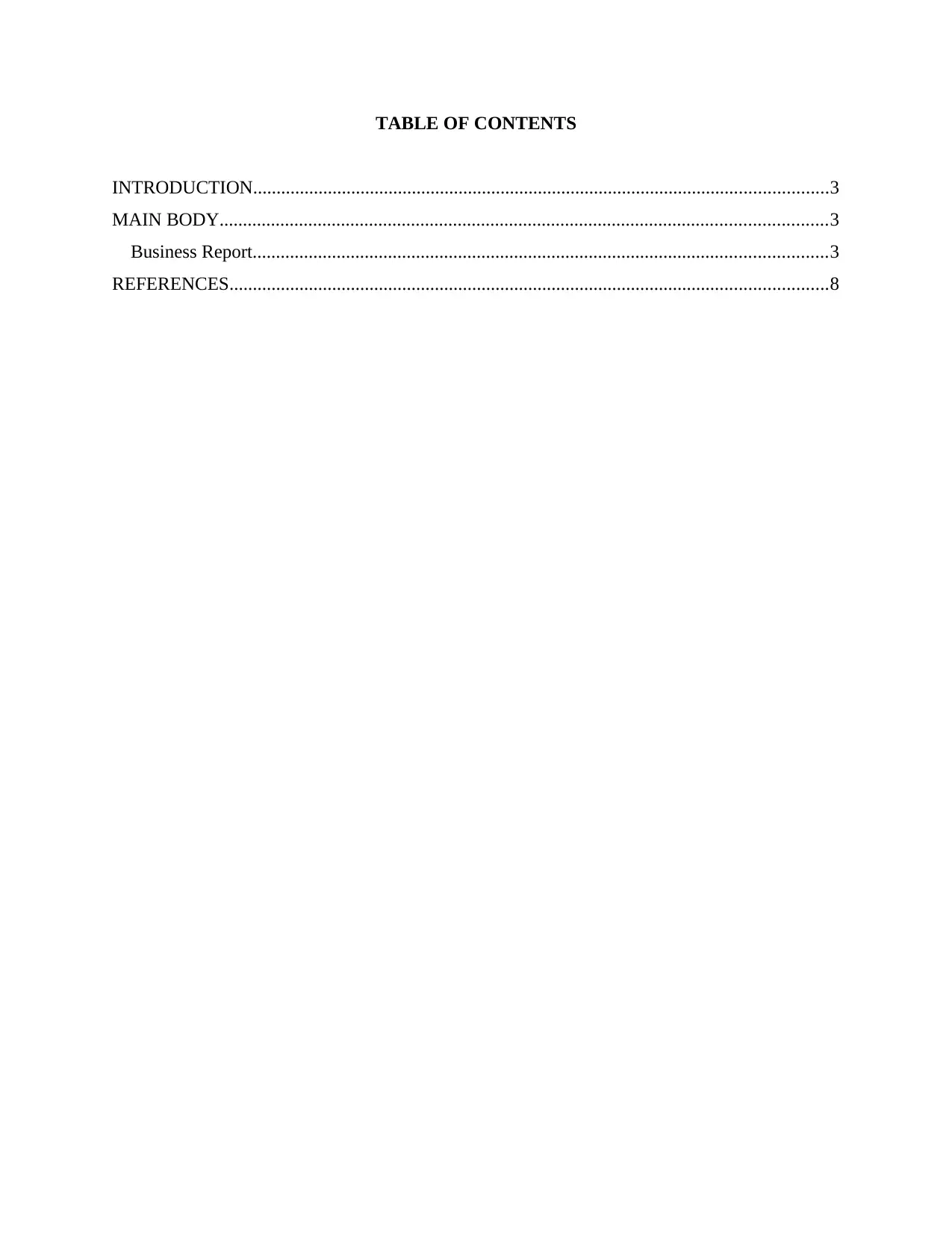
TABLE OF CONTENTS
INTRODUCTION...........................................................................................................................3
MAIN BODY..................................................................................................................................3
Business Report...........................................................................................................................3
REFERENCES................................................................................................................................8
INTRODUCTION...........................................................................................................................3
MAIN BODY..................................................................................................................................3
Business Report...........................................................................................................................3
REFERENCES................................................................................................................................8
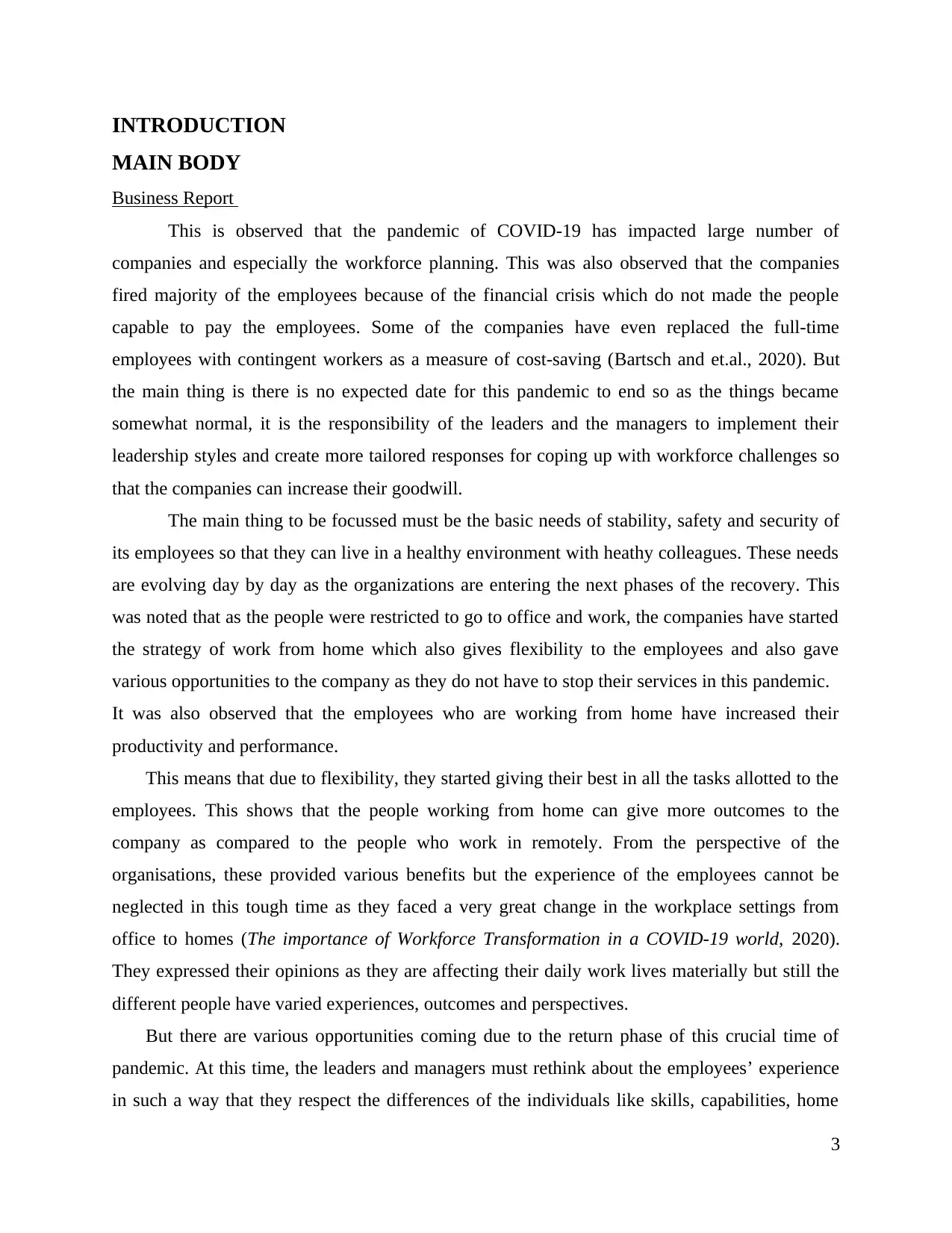
INTRODUCTION
MAIN BODY
Business Report
This is observed that the pandemic of COVID-19 has impacted large number of
companies and especially the workforce planning. This was also observed that the companies
fired majority of the employees because of the financial crisis which do not made the people
capable to pay the employees. Some of the companies have even replaced the full-time
employees with contingent workers as a measure of cost-saving (Bartsch and et.al., 2020). But
the main thing is there is no expected date for this pandemic to end so as the things became
somewhat normal, it is the responsibility of the leaders and the managers to implement their
leadership styles and create more tailored responses for coping up with workforce challenges so
that the companies can increase their goodwill.
The main thing to be focussed must be the basic needs of stability, safety and security of
its employees so that they can live in a healthy environment with heathy colleagues. These needs
are evolving day by day as the organizations are entering the next phases of the recovery. This
was noted that as the people were restricted to go to office and work, the companies have started
the strategy of work from home which also gives flexibility to the employees and also gave
various opportunities to the company as they do not have to stop their services in this pandemic.
It was also observed that the employees who are working from home have increased their
productivity and performance.
This means that due to flexibility, they started giving their best in all the tasks allotted to the
employees. This shows that the people working from home can give more outcomes to the
company as compared to the people who work in remotely. From the perspective of the
organisations, these provided various benefits but the experience of the employees cannot be
neglected in this tough time as they faced a very great change in the workplace settings from
office to homes (The importance of Workforce Transformation in a COVID-19 world, 2020).
They expressed their opinions as they are affecting their daily work lives materially but still the
different people have varied experiences, outcomes and perspectives.
But there are various opportunities coming due to the return phase of this crucial time of
pandemic. At this time, the leaders and managers must rethink about the employees’ experience
in such a way that they respect the differences of the individuals like skills, capabilities, home
3
MAIN BODY
Business Report
This is observed that the pandemic of COVID-19 has impacted large number of
companies and especially the workforce planning. This was also observed that the companies
fired majority of the employees because of the financial crisis which do not made the people
capable to pay the employees. Some of the companies have even replaced the full-time
employees with contingent workers as a measure of cost-saving (Bartsch and et.al., 2020). But
the main thing is there is no expected date for this pandemic to end so as the things became
somewhat normal, it is the responsibility of the leaders and the managers to implement their
leadership styles and create more tailored responses for coping up with workforce challenges so
that the companies can increase their goodwill.
The main thing to be focussed must be the basic needs of stability, safety and security of
its employees so that they can live in a healthy environment with heathy colleagues. These needs
are evolving day by day as the organizations are entering the next phases of the recovery. This
was noted that as the people were restricted to go to office and work, the companies have started
the strategy of work from home which also gives flexibility to the employees and also gave
various opportunities to the company as they do not have to stop their services in this pandemic.
It was also observed that the employees who are working from home have increased their
productivity and performance.
This means that due to flexibility, they started giving their best in all the tasks allotted to the
employees. This shows that the people working from home can give more outcomes to the
company as compared to the people who work in remotely. From the perspective of the
organisations, these provided various benefits but the experience of the employees cannot be
neglected in this tough time as they faced a very great change in the workplace settings from
office to homes (The importance of Workforce Transformation in a COVID-19 world, 2020).
They expressed their opinions as they are affecting their daily work lives materially but still the
different people have varied experiences, outcomes and perspectives.
But there are various opportunities coming due to the return phase of this crucial time of
pandemic. At this time, the leaders and managers must rethink about the employees’ experience
in such a way that they respect the differences of the individuals like skills, capabilities, home
3
⊘ This is a preview!⊘
Do you want full access?
Subscribe today to unlock all pages.

Trusted by 1+ million students worldwide
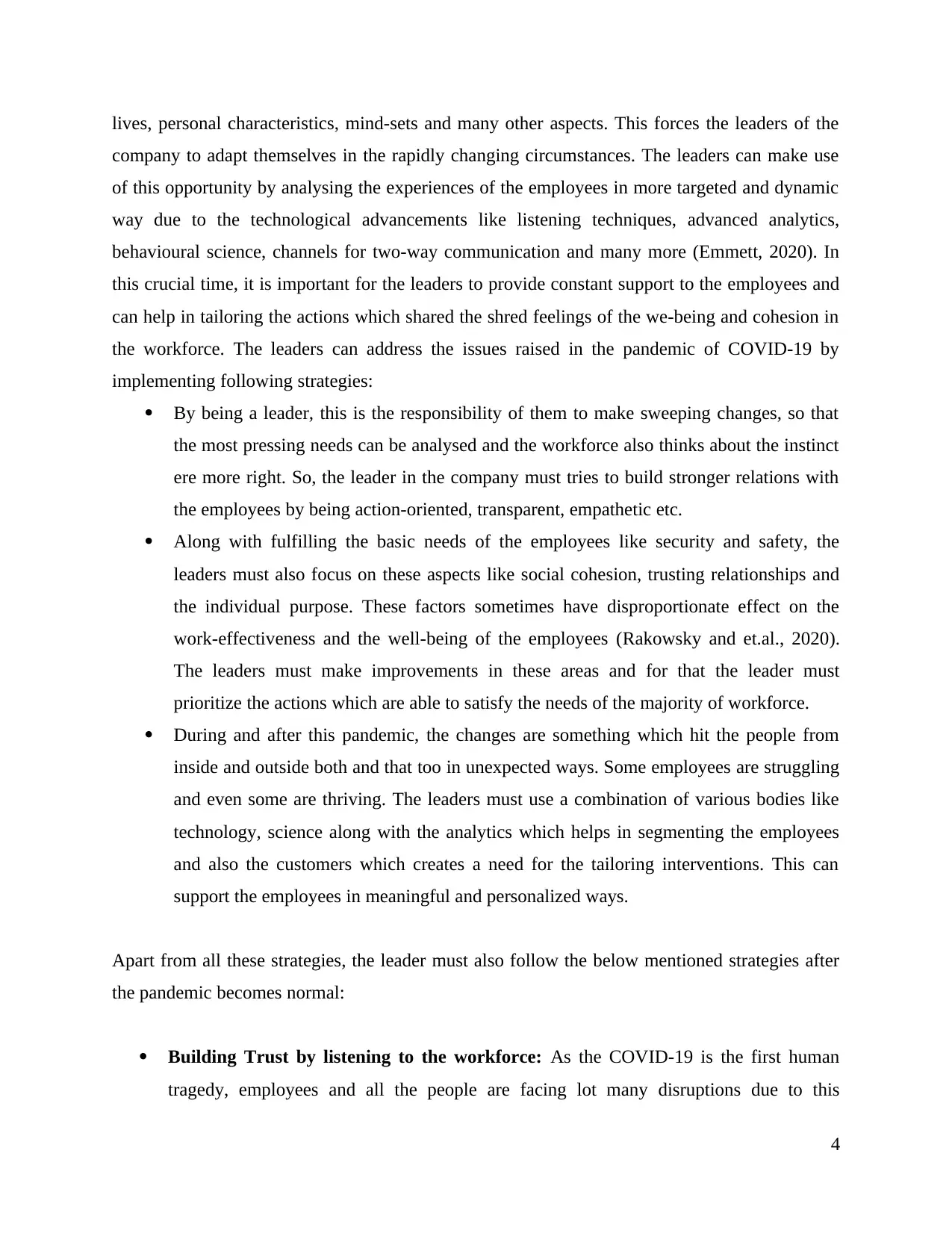
lives, personal characteristics, mind-sets and many other aspects. This forces the leaders of the
company to adapt themselves in the rapidly changing circumstances. The leaders can make use
of this opportunity by analysing the experiences of the employees in more targeted and dynamic
way due to the technological advancements like listening techniques, advanced analytics,
behavioural science, channels for two-way communication and many more (Emmett, 2020). In
this crucial time, it is important for the leaders to provide constant support to the employees and
can help in tailoring the actions which shared the shred feelings of the we-being and cohesion in
the workforce. The leaders can address the issues raised in the pandemic of COVID-19 by
implementing following strategies:
By being a leader, this is the responsibility of them to make sweeping changes, so that
the most pressing needs can be analysed and the workforce also thinks about the instinct
ere more right. So, the leader in the company must tries to build stronger relations with
the employees by being action-oriented, transparent, empathetic etc.
Along with fulfilling the basic needs of the employees like security and safety, the
leaders must also focus on these aspects like social cohesion, trusting relationships and
the individual purpose. These factors sometimes have disproportionate effect on the
work-effectiveness and the well-being of the employees (Rakowsky and et.al., 2020).
The leaders must make improvements in these areas and for that the leader must
prioritize the actions which are able to satisfy the needs of the majority of workforce.
During and after this pandemic, the changes are something which hit the people from
inside and outside both and that too in unexpected ways. Some employees are struggling
and even some are thriving. The leaders must use a combination of various bodies like
technology, science along with the analytics which helps in segmenting the employees
and also the customers which creates a need for the tailoring interventions. This can
support the employees in meaningful and personalized ways.
Apart from all these strategies, the leader must also follow the below mentioned strategies after
the pandemic becomes normal:
Building Trust by listening to the workforce: As the COVID-19 is the first human
tragedy, employees and all the people are facing lot many disruptions due to this
4
company to adapt themselves in the rapidly changing circumstances. The leaders can make use
of this opportunity by analysing the experiences of the employees in more targeted and dynamic
way due to the technological advancements like listening techniques, advanced analytics,
behavioural science, channels for two-way communication and many more (Emmett, 2020). In
this crucial time, it is important for the leaders to provide constant support to the employees and
can help in tailoring the actions which shared the shred feelings of the we-being and cohesion in
the workforce. The leaders can address the issues raised in the pandemic of COVID-19 by
implementing following strategies:
By being a leader, this is the responsibility of them to make sweeping changes, so that
the most pressing needs can be analysed and the workforce also thinks about the instinct
ere more right. So, the leader in the company must tries to build stronger relations with
the employees by being action-oriented, transparent, empathetic etc.
Along with fulfilling the basic needs of the employees like security and safety, the
leaders must also focus on these aspects like social cohesion, trusting relationships and
the individual purpose. These factors sometimes have disproportionate effect on the
work-effectiveness and the well-being of the employees (Rakowsky and et.al., 2020).
The leaders must make improvements in these areas and for that the leader must
prioritize the actions which are able to satisfy the needs of the majority of workforce.
During and after this pandemic, the changes are something which hit the people from
inside and outside both and that too in unexpected ways. Some employees are struggling
and even some are thriving. The leaders must use a combination of various bodies like
technology, science along with the analytics which helps in segmenting the employees
and also the customers which creates a need for the tailoring interventions. This can
support the employees in meaningful and personalized ways.
Apart from all these strategies, the leader must also follow the below mentioned strategies after
the pandemic becomes normal:
Building Trust by listening to the workforce: As the COVID-19 is the first human
tragedy, employees and all the people are facing lot many disruptions due to this
4
Paraphrase This Document
Need a fresh take? Get an instant paraphrase of this document with our AI Paraphraser
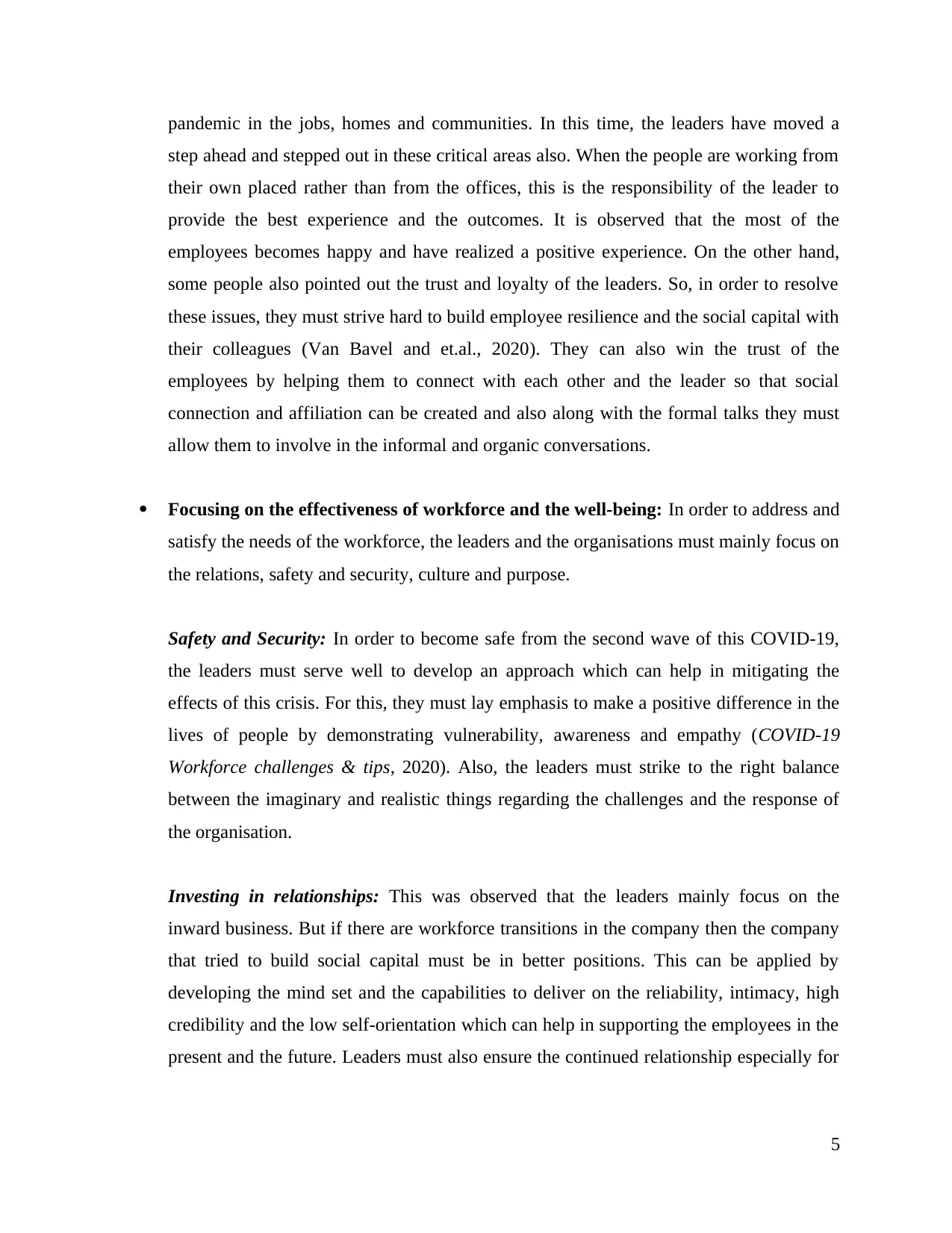
pandemic in the jobs, homes and communities. In this time, the leaders have moved a
step ahead and stepped out in these critical areas also. When the people are working from
their own placed rather than from the offices, this is the responsibility of the leader to
provide the best experience and the outcomes. It is observed that the most of the
employees becomes happy and have realized a positive experience. On the other hand,
some people also pointed out the trust and loyalty of the leaders. So, in order to resolve
these issues, they must strive hard to build employee resilience and the social capital with
their colleagues (Van Bavel and et.al., 2020). They can also win the trust of the
employees by helping them to connect with each other and the leader so that social
connection and affiliation can be created and also along with the formal talks they must
allow them to involve in the informal and organic conversations.
Focusing on the effectiveness of workforce and the well-being: In order to address and
satisfy the needs of the workforce, the leaders and the organisations must mainly focus on
the relations, safety and security, culture and purpose.
Safety and Security: In order to become safe from the second wave of this COVID-19,
the leaders must serve well to develop an approach which can help in mitigating the
effects of this crisis. For this, they must lay emphasis to make a positive difference in the
lives of people by demonstrating vulnerability, awareness and empathy (COVID-19
Workforce challenges & tips, 2020). Also, the leaders must strike to the right balance
between the imaginary and realistic things regarding the challenges and the response of
the organisation.
Investing in relationships: This was observed that the leaders mainly focus on the
inward business. But if there are workforce transitions in the company then the company
that tried to build social capital must be in better positions. This can be applied by
developing the mind set and the capabilities to deliver on the reliability, intimacy, high
credibility and the low self-orientation which can help in supporting the employees in the
present and the future. Leaders must also ensure the continued relationship especially for
5
step ahead and stepped out in these critical areas also. When the people are working from
their own placed rather than from the offices, this is the responsibility of the leader to
provide the best experience and the outcomes. It is observed that the most of the
employees becomes happy and have realized a positive experience. On the other hand,
some people also pointed out the trust and loyalty of the leaders. So, in order to resolve
these issues, they must strive hard to build employee resilience and the social capital with
their colleagues (Van Bavel and et.al., 2020). They can also win the trust of the
employees by helping them to connect with each other and the leader so that social
connection and affiliation can be created and also along with the formal talks they must
allow them to involve in the informal and organic conversations.
Focusing on the effectiveness of workforce and the well-being: In order to address and
satisfy the needs of the workforce, the leaders and the organisations must mainly focus on
the relations, safety and security, culture and purpose.
Safety and Security: In order to become safe from the second wave of this COVID-19,
the leaders must serve well to develop an approach which can help in mitigating the
effects of this crisis. For this, they must lay emphasis to make a positive difference in the
lives of people by demonstrating vulnerability, awareness and empathy (COVID-19
Workforce challenges & tips, 2020). Also, the leaders must strike to the right balance
between the imaginary and realistic things regarding the challenges and the response of
the organisation.
Investing in relationships: This was observed that the leaders mainly focus on the
inward business. But if there are workforce transitions in the company then the company
that tried to build social capital must be in better positions. This can be applied by
developing the mind set and the capabilities to deliver on the reliability, intimacy, high
credibility and the low self-orientation which can help in supporting the employees in the
present and the future. Leaders must also ensure the continued relationship especially for
5
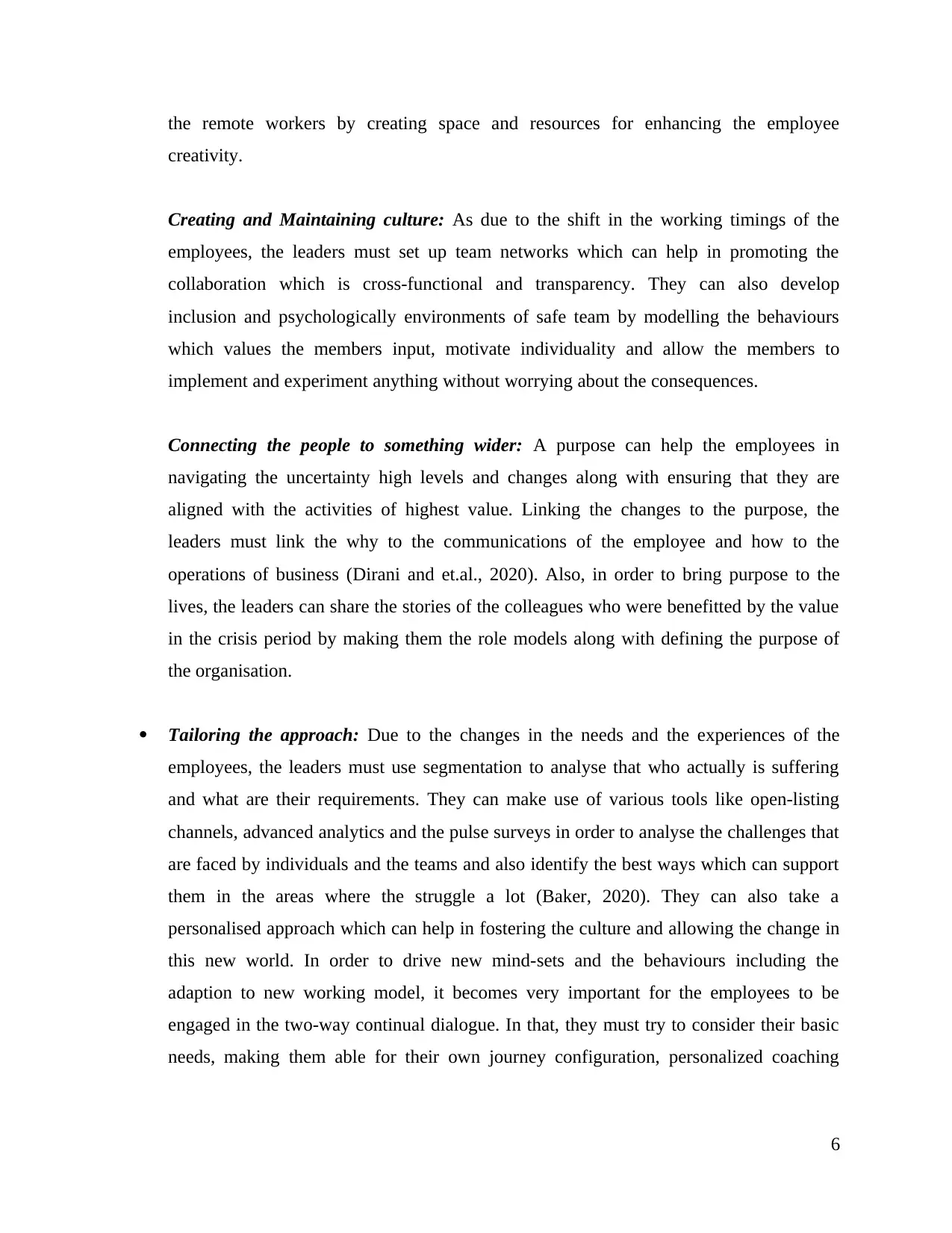
the remote workers by creating space and resources for enhancing the employee
creativity.
Creating and Maintaining culture: As due to the shift in the working timings of the
employees, the leaders must set up team networks which can help in promoting the
collaboration which is cross-functional and transparency. They can also develop
inclusion and psychologically environments of safe team by modelling the behaviours
which values the members input, motivate individuality and allow the members to
implement and experiment anything without worrying about the consequences.
Connecting the people to something wider: A purpose can help the employees in
navigating the uncertainty high levels and changes along with ensuring that they are
aligned with the activities of highest value. Linking the changes to the purpose, the
leaders must link the why to the communications of the employee and how to the
operations of business (Dirani and et.al., 2020). Also, in order to bring purpose to the
lives, the leaders can share the stories of the colleagues who were benefitted by the value
in the crisis period by making them the role models along with defining the purpose of
the organisation.
Tailoring the approach: Due to the changes in the needs and the experiences of the
employees, the leaders must use segmentation to analyse that who actually is suffering
and what are their requirements. They can make use of various tools like open-listing
channels, advanced analytics and the pulse surveys in order to analyse the challenges that
are faced by individuals and the teams and also identify the best ways which can support
them in the areas where the struggle a lot (Baker, 2020). They can also take a
personalised approach which can help in fostering the culture and allowing the change in
this new world. In order to drive new mind-sets and the behaviours including the
adaption to new working model, it becomes very important for the employees to be
engaged in the two-way continual dialogue. In that, they must try to consider their basic
needs, making them able for their own journey configuration, personalized coaching
6
creativity.
Creating and Maintaining culture: As due to the shift in the working timings of the
employees, the leaders must set up team networks which can help in promoting the
collaboration which is cross-functional and transparency. They can also develop
inclusion and psychologically environments of safe team by modelling the behaviours
which values the members input, motivate individuality and allow the members to
implement and experiment anything without worrying about the consequences.
Connecting the people to something wider: A purpose can help the employees in
navigating the uncertainty high levels and changes along with ensuring that they are
aligned with the activities of highest value. Linking the changes to the purpose, the
leaders must link the why to the communications of the employee and how to the
operations of business (Dirani and et.al., 2020). Also, in order to bring purpose to the
lives, the leaders can share the stories of the colleagues who were benefitted by the value
in the crisis period by making them the role models along with defining the purpose of
the organisation.
Tailoring the approach: Due to the changes in the needs and the experiences of the
employees, the leaders must use segmentation to analyse that who actually is suffering
and what are their requirements. They can make use of various tools like open-listing
channels, advanced analytics and the pulse surveys in order to analyse the challenges that
are faced by individuals and the teams and also identify the best ways which can support
them in the areas where the struggle a lot (Baker, 2020). They can also take a
personalised approach which can help in fostering the culture and allowing the change in
this new world. In order to drive new mind-sets and the behaviours including the
adaption to new working model, it becomes very important for the employees to be
engaged in the two-way continual dialogue. In that, they must try to consider their basic
needs, making them able for their own journey configuration, personalized coaching
6
⊘ This is a preview!⊘
Do you want full access?
Subscribe today to unlock all pages.

Trusted by 1+ million students worldwide
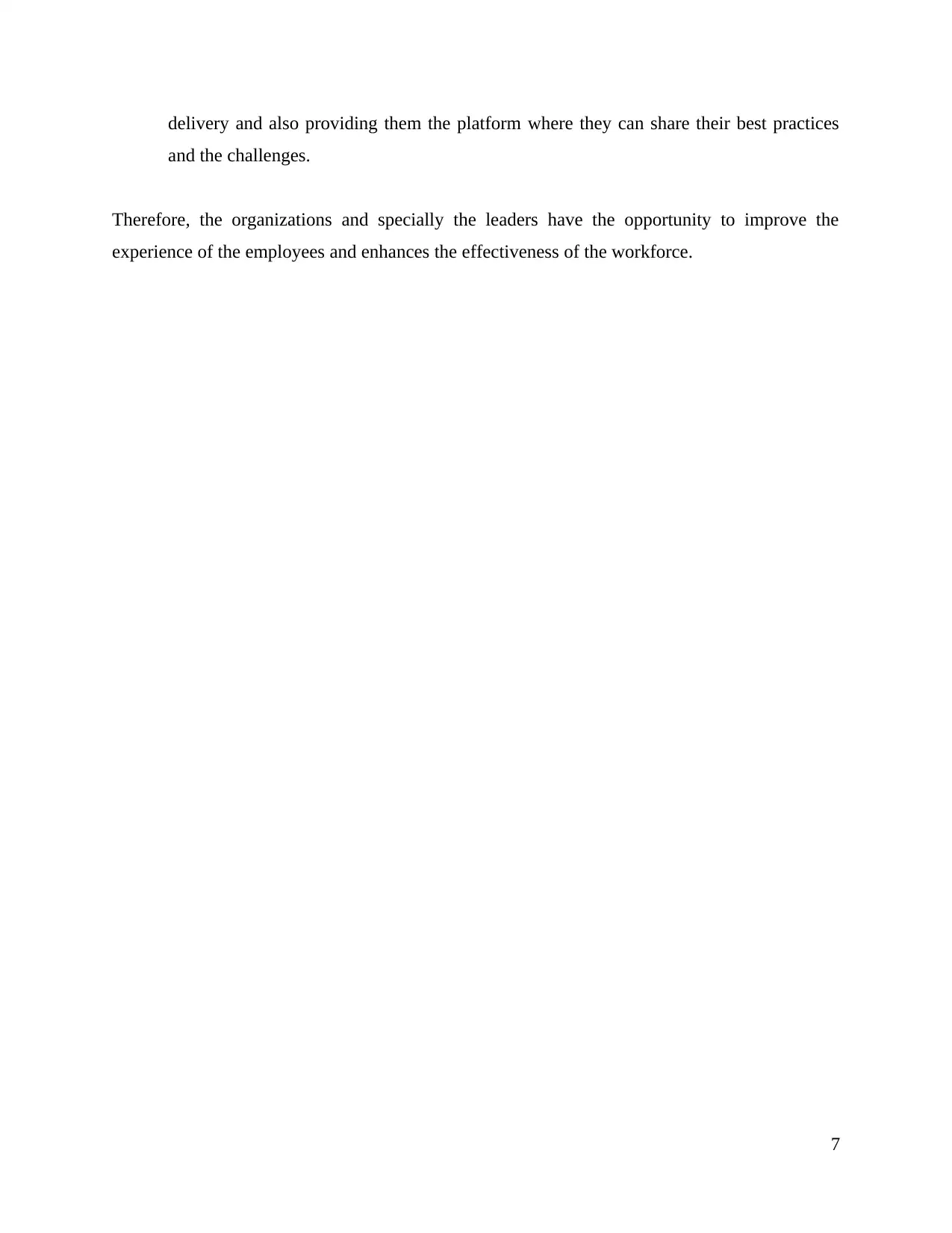
delivery and also providing them the platform where they can share their best practices
and the challenges.
Therefore, the organizations and specially the leaders have the opportunity to improve the
experience of the employees and enhances the effectiveness of the workforce.
7
and the challenges.
Therefore, the organizations and specially the leaders have the opportunity to improve the
experience of the employees and enhances the effectiveness of the workforce.
7
Paraphrase This Document
Need a fresh take? Get an instant paraphrase of this document with our AI Paraphraser
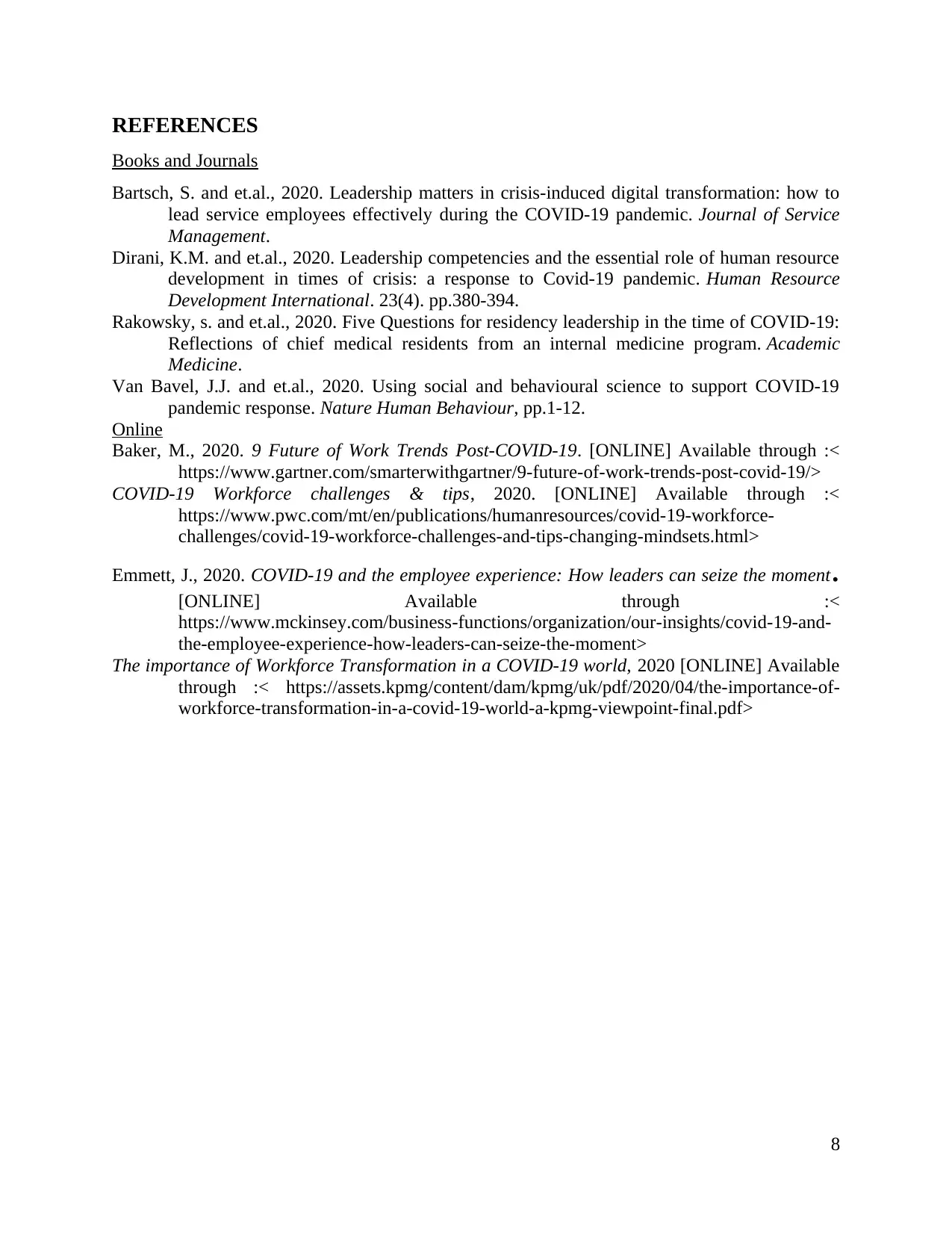
REFERENCES
Books and Journals
Bartsch, S. and et.al., 2020. Leadership matters in crisis-induced digital transformation: how to
lead service employees effectively during the COVID-19 pandemic. Journal of Service
Management.
Dirani, K.M. and et.al., 2020. Leadership competencies and the essential role of human resource
development in times of crisis: a response to Covid-19 pandemic. Human Resource
Development International. 23(4). pp.380-394.
Rakowsky, s. and et.al., 2020. Five Questions for residency leadership in the time of COVID-19:
Reflections of chief medical residents from an internal medicine program. Academic
Medicine.
Van Bavel, J.J. and et.al., 2020. Using social and behavioural science to support COVID-19
pandemic response. Nature Human Behaviour, pp.1-12.
Online
Baker, M., 2020. 9 Future of Work Trends Post-COVID-19. [ONLINE] Available through :<
https://www.gartner.com/smarterwithgartner/9-future-of-work-trends-post-covid-19/>
COVID-19 Workforce challenges & tips, 2020. [ONLINE] Available through :<
https://www.pwc.com/mt/en/publications/humanresources/covid-19-workforce-
challenges/covid-19-workforce-challenges-and-tips-changing-mindsets.html>
Emmett, J., 2020. COVID-19 and the employee experience: How leaders can seize the moment.
[ONLINE] Available through :<
https://www.mckinsey.com/business-functions/organization/our-insights/covid-19-and-
the-employee-experience-how-leaders-can-seize-the-moment>
The importance of Workforce Transformation in a COVID-19 world, 2020 [ONLINE] Available
through :< https://assets.kpmg/content/dam/kpmg/uk/pdf/2020/04/the-importance-of-
workforce-transformation-in-a-covid-19-world-a-kpmg-viewpoint-final.pdf>
8
Books and Journals
Bartsch, S. and et.al., 2020. Leadership matters in crisis-induced digital transformation: how to
lead service employees effectively during the COVID-19 pandemic. Journal of Service
Management.
Dirani, K.M. and et.al., 2020. Leadership competencies and the essential role of human resource
development in times of crisis: a response to Covid-19 pandemic. Human Resource
Development International. 23(4). pp.380-394.
Rakowsky, s. and et.al., 2020. Five Questions for residency leadership in the time of COVID-19:
Reflections of chief medical residents from an internal medicine program. Academic
Medicine.
Van Bavel, J.J. and et.al., 2020. Using social and behavioural science to support COVID-19
pandemic response. Nature Human Behaviour, pp.1-12.
Online
Baker, M., 2020. 9 Future of Work Trends Post-COVID-19. [ONLINE] Available through :<
https://www.gartner.com/smarterwithgartner/9-future-of-work-trends-post-covid-19/>
COVID-19 Workforce challenges & tips, 2020. [ONLINE] Available through :<
https://www.pwc.com/mt/en/publications/humanresources/covid-19-workforce-
challenges/covid-19-workforce-challenges-and-tips-changing-mindsets.html>
Emmett, J., 2020. COVID-19 and the employee experience: How leaders can seize the moment.
[ONLINE] Available through :<
https://www.mckinsey.com/business-functions/organization/our-insights/covid-19-and-
the-employee-experience-how-leaders-can-seize-the-moment>
The importance of Workforce Transformation in a COVID-19 world, 2020 [ONLINE] Available
through :< https://assets.kpmg/content/dam/kpmg/uk/pdf/2020/04/the-importance-of-
workforce-transformation-in-a-covid-19-world-a-kpmg-viewpoint-final.pdf>
8

9
⊘ This is a preview!⊘
Do you want full access?
Subscribe today to unlock all pages.

Trusted by 1+ million students worldwide
1 out of 9
Related Documents
Your All-in-One AI-Powered Toolkit for Academic Success.
+13062052269
info@desklib.com
Available 24*7 on WhatsApp / Email
![[object Object]](/_next/static/media/star-bottom.7253800d.svg)
Unlock your academic potential
Copyright © 2020–2025 A2Z Services. All Rights Reserved. Developed and managed by ZUCOL.





